Pros
Cons
Introduction
Overall Design
{{section_header}}{{section.name}}{{/section_header}}
The {{product.name}} has what Sony calls a "monolithic design," which means the front is an unbroken sheet of glass. It still has a bezel, mind you, but it's underneath the glass. Its thin, glass-and-metal look is accentuated by an illuminated, bluish-white Sony logo. A couple of LEDs on the lower left corner light up or blink to indicate power or communication with the remote. While it probably won't cause you to evolve if you touch it, we do think it looks very stately.
Front
{{section_header}}{{section.name}}{{/section_header}}

Back
{{section_header}}{{section.name}}{{/section_header}}

Sides
{{section_header}}{{section.name}}{{/section_header}}

Stand/Mount
{{section_header}}{{section.name}}{{/section_header}}
The black, brushed-metal stand matches the thin, glass look of the {{product.name}}. It swivels, which is good, as the thing has a monolithic heft to go with its monolithic design.

Controls
{{section_header}}{{section.name}}{{/section_header}}
The on-board controls for the {{product.name}} consist of a series of plastic buttons set in the rear of the TV's lower right side. We appreciate these easy-to-see buttons with good tactile feedback, in contrast to the touch-sensitive controls we have found increasingly popular. These are impossible to feel and difficult to see, even before they get immediately covered in fingerprints.

Remote Control
{{section_header}}{{section.name}}{{/section_header}}
If the {{product.name}}'s design is "monolithic," then so is its remote. At ten inches, it's extremely long, with a concave surface covered in tiny buttons. The uniformity of the plethora of buttons is a bit overwhelming, and the volume and channel rockers are on the small side. However, the buttons offer great tactile feedback, and a glow-in-the-dark button can spark blue rim-lighting for most—but not all—of them.
The remote even has a red Netflix button, as well as a lavender one for Qriocity. We aren't sure how useful the latter will be, but given the popularity of Netflix, having a dedicated button for it seems like a smart move.
Like other recent Sony remotes, there's a round power button on its underside. While it might seem easy to press accidentally, its recession in the plastic and the strength required to initiate a response will likely prevent this from happening.

In the Box
{{section_header}}{{section.name}}{{/section_header}}
The {{product.name}} ships in a gigantic box with its remote, batteries, setup guide, and an adapter for the nonstandard A/V and component ports. It isn't any more difficult than other 55-inch TVs to set up. That said, 55 inches is a lot of inches to lift by oneself when it's made of solid metal and glass. And it's really not worth the risk, is it?
Black Level
{{section_header}}{{section.name}}{{/section_header}}
The {{product.name}} produced a black level of 0.07 cd/m2, which equates to a deep, rich black. While not being the darkest black possible, it's well below the 0.20 cd/m2 threshold at which it can interfere with enjoyment of dark scenes. More on how we test black level.
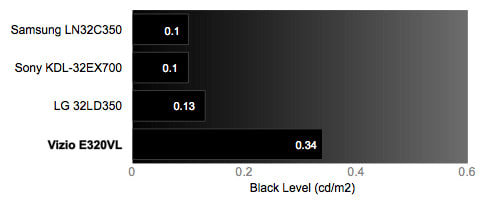
Peak Brightness
{{section_header}}{{section.name}}{{/section_header}}
With a luminance of 284.78 cd/m2, the {{product.name}} produced plenty of light. Anything above 200 cd/m2 will suffice in a dark room, and this TV could probably hold its own in a room with more standard lighting. More on how we test peak brightness.
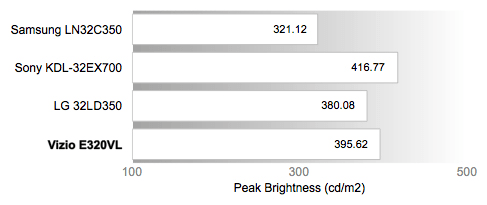
Contrast
{{section_header}}{{section.name}}{{/section_header}}
The Sony's contrast level was high, which is to be expected given its high peak brightness and dark black level. More on how we test contrast.

Tunnel Contrast
{{section_header}}{{section.name}}{{/section_header}}
LCDs do not generally have a problem with our tunnel contrast test, in which we measure the black level of a shrinking black rectangle surrounded by pure white. Regardless, the {{product.name}} performed exceptionally well. More on how we test tunnel contrast.
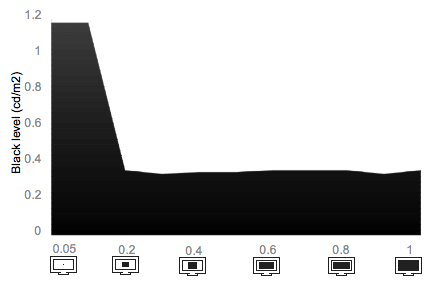
White Falloff
{{section_header}}{{section.name}}{{/section_header}}
As with the tunnel contrast test, the white falloff test measures a shrinking white box on a black screen. The {{product.name}} had no problem whatsoever displaying bright whites, even when surrounded by black pixels. As a result, this TV should produce vivid pictures of of light-and-dark intricacies. More on how we test white falloff.
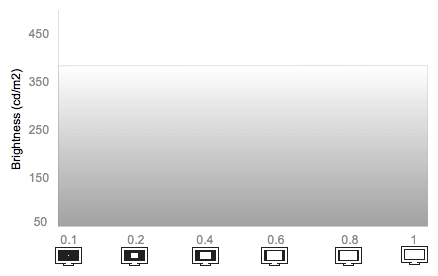
Uniformity
Greyscale Gamma
{{section_header}}{{section.name}}{{/section_header}}
An ideal greyscale gamma has a slope between 2.1 and 2.2. With a slope of 2.62, the {{product.name}}'s gamma is a bit steep. Interestingly, the slope usually sags down at the center, ending at a flat tail. On the contrary, this graph is quite straight, with a mild upward arch. That means that greys transition from white to black very smoothly, while retaining detail in shadows and bright scenes. More on how we test greyscale gamma.
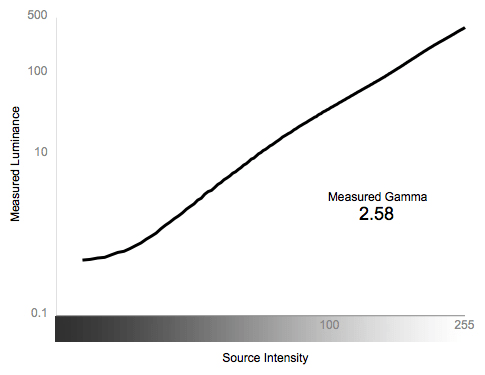
Color Temperature
{{section_header}}{{section.name}}{{/section_header}}
The {{product.name}} showed great color accuracy in our tests. As we had it output every shade of grey from black to white, its color temperature very rarely strayed beyond a margin of perceptibility. More on how we test color temperature.

RGB Curves
{{section_header}}{{section.name}}{{/section_header}}
The curves for each color gradient on the {{product.name}} were smooth and even, in general. They exhibited minor problems, such as the weaker color intensity of blue, or its wiggly, erratic nature near the top of the curve. However, any color banding this causes in the gradients should be relatively minor. Even though blue is slightly weaker than the other two colors, it should not make a noticeable difference when watching video. More on how we test RGB curves.

Below, you can see some representations of the RGB channel gradients of the {{product.name}} and a few of its competitors. Color banding in the bright blue side of the blue strip is, as you can see, minimal.
Motion Performance
{{section_header}}{{section.name}}{{/section_header}}
Motion on the {{product.name}} was solidly disappointing. Not only was it a bit blurrier than we'd hope, but straight edges skewed into diagonals as they moved across the screen. Images were also broken up by horizontal scan lines that coincided with a stair-stepping along the edge. 1080i inputs, which are used on some cable channels, made this effect even more noticeable. All in all, we expected better from a high-end TV like this one. More on how we test motion performance.
3:2 Pulldown & 24fps
{{section_header}}{{section.name}}{{/section_header}}
If we were disappointed by the motion performance, we were stunned when we tried to play a 24fps Blu-ray with high-frequency movement. The pattern flickered crazily as the {{product.name}}'s tiny, metaphorical brain struggled to figure out how to draw it moving in a 60fps format. We turned on CineMotion to improve the results, but unlike on other Sony models we've tried, both Auto1 and Auto2 settings seemed to actually make it worse. For a moving stadium scene, we had more success with Auto1, which seemed to improve mosquito crawl slightly. Again, we had hoped for more from this Sony. More on how we test 3:2 pulldown and 24fps.
Resolution Scaling
{{section_header}}{{section.name}}{{/section_header}}
Resolution scaling was all right, but not great. It's worth noting that in its native resolution of 1080p, it sometimes displayed greyscale moiré (moire) patterns as a false green. Overall, it scaled high-frequency patterns with a high accuracy, though it had some problems with legibility. More on how we test resolution scaling.
480p
Moiré (moire) patterns were a little fuzzy, but displayed no major error. A high-frequency pattern was spot-on, as well. Legibility seemed to be an issue, however, as even larger fonts appeared smeared and blurry.
720p
There was a minimal amount of error in the display of high-frequency patterns and moiré (moire) designs, which had some false plaids. While better than the text output in 480p, even 12pt fonts had a blurry halo, and smaller ones looked more smeared.
1080i
Moiré (moire) patterns in 1080i frequently rendered as some kind of plaid, which did not happen in the 1080p. At least they weren't green, however. Text was more legible, however wiggly-looking.
3D Effect & Experience
{{section_header}}{{section.name}}{{/section_header}}
The {{product.name}} did a reasonably good job displaying 3D, overall. It was leaps ahead of last year's LCDs, and especially convincing in scenes without movement. We still think that plasmas have an advantage over LCDs when it comes to minimizing crosstalk and generating a convincing 3D experience. So while we would count this model among the best 3D LCD TVs, we aren't convinced that it's worth it in the end. In displaying fast movement and objects in the foreground, there is still some "double vision," although it's not as noticeable as last year's crude attempts.
We had to turn the Picture setting down to 88 from our standard calibration to regain some of the contrast lost by the addition of the 3D glasses.
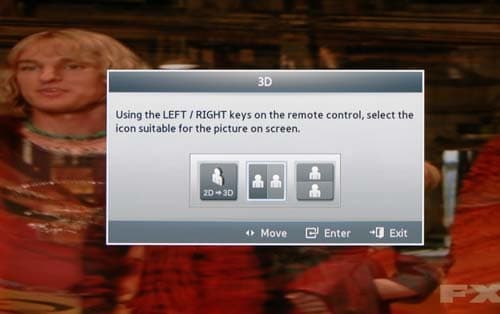
Some of the options in the 3D menu
3D Black & White
{{section_header}}{{section.name}}{{/section_header}}
The {{product.name}} only cleared the 200 cd/m2 minimum for brightness by a small amount, so after putting on the active shutter glasses, the screen looked quite dark indeed. It only produced about 32.69 cd/m2 through the glasses. Along with the plummet in luminance came a 770% drop in contrast. The black level did get darker, as you would expect, but not nearly enough to counterbalance the overall drop in brightness.

3D Color
{{section_header}}{{section.name}}{{/section_header}}
The 3D color temperature stability was about average: much worse than the color temperature of the television in standard 2D. It spiked into blue quite strongly for light greys up until white on a greyscale gradient.
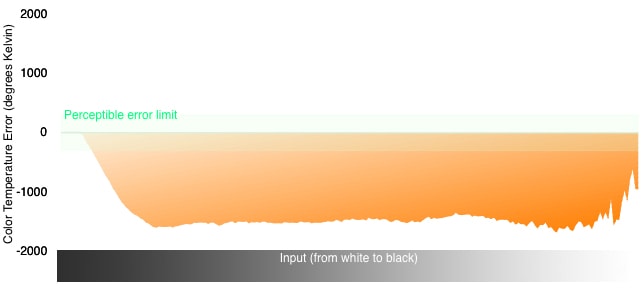
For some reason, the blue curve on the {{product.name}} was much worse than the red and green ones. They maintained an even slope for 2D and 3D sources both. However, the blue curve for 3D input was much worse, and never truly reached a dark, black-toned blue. Instead it stopped at about 20% of the darkest blue value and stayed there for all darker blues. Not only will you not be able to see very dark blues, but the wiggly nature of this line means there will be a lot of color banding for blue shades. The TV is not very good at differentiating similar shades of blue, and if it presents a blue gradient, you may see stripes marring the smooth gradation.
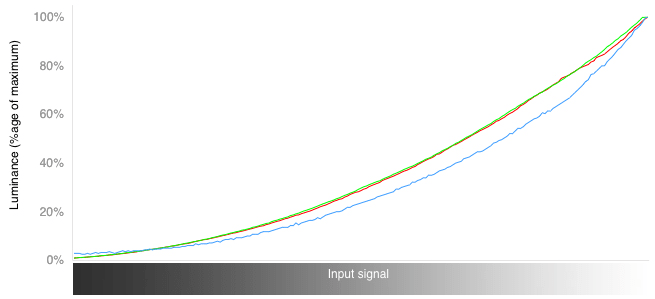
Compared to the 2D color gamut, the color gamut for 3D is not as accurate. Blue is very undersaturated, as seen in the curves above, which never achieve a very deep blue. Red is slightly undersaturated, beyond the already-undersaturated value it put up for 2D sources. Finally, green is shifted a little towards yellow. The redeeming quality of 3D versus 2D color is that the white point is slightly more accurate in 3D, even if it is a bit greenish.
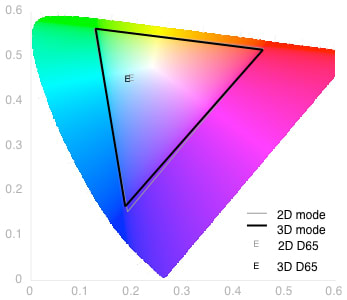
3D Crosstalk
{{section_header}}{{section.name}}{{/section_header}}
3D works because it shows a slightly different image in each eye. When one image "leaks" into the wrong eye, it's called crosstalk, and causes most of the problems with non-immersive 3D. This TV was all right at reducing crosstalk, but not nearly as good as some plasmas, and not even as good as an LCD by LG this year. Scenes containing a lot of white or green on black produce the most crosstalk, by far. It's an improvement over last year's 3D LCDs, but still doesn't wow us.
3D Glasses
{{section_header}}{{section.name}}{{/section_header}}
The glasses are uncomfortable, but not nearly as bad as the bulky frames from last year. They are forward-weighted and rest heavily on the bridge of the nose. Additionally, we had a hard time fitting them over our nerd-decrying prescription glasses. A pair does not ship with the TV, so you'll need to spend $70 for each. 3D, like other technology, seems to be trending both better and cheaper as time goes on. We're not on board yet, though.
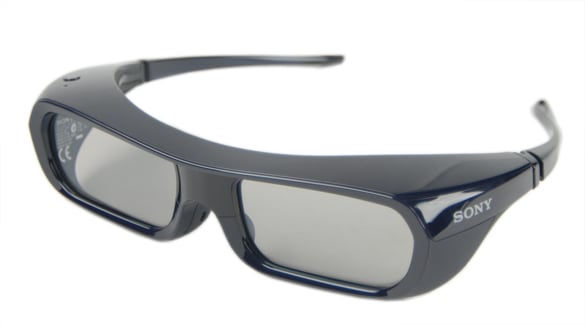
Yes, you will look like a dork with these on
Formats
{{section_header}}{{section.name}}{{/section_header}}
The {{product.name}} is capable of displaying all NTSC standard resolutions, and can interpret 24fps input. Additionally, it can output in xvYCC color mode, now called Deep Color.
Viewing Angle
{{section_header}}{{section.name}}{{/section_header}}
The viewing angle of the {{product.name}} was strikingly poor, falling below 50% of its maximum contrast when only 8˚ off-center. With a total viewing angle of 17˚, you will need to position yourself right in front of the TV for the best results. Although the contrast falls dramatically, the color remains relatively true.

Reflectance
{{section_header}}{{section.name}}{{/section_header}}
The screen of the {{product.name}} was quite reflective. On a bright screen it wasn't so bad, but on a black screen, long lines streaked orthogonally out from our light source's reflection with rainbows shooting out at diagonals. Angling the light source away from the screen helps minimize the problem, but we think this TV is best suited for dark rooms. Its brightness doesn't clear the 200 cd/m2 by very much, so we fear it would be washed out in a well-lit environment.
Video Processing
{{section_header}}{{section.name}}{{/section_header}}
The {{product.name}} has a slew of video processing features. Whether they are of any use will be up to you, the viewer.
Calibration
{{section_header}}{{section.name}}{{/section_header}}
We use DisplayMate calibration software and a spectrophotometer to calibrate our televisions before putting them through our tests. You can see our optimized calibration for viewing in a dark room below.
One of the signs of a good television is that it doesn't require much adjustment to calibrate. The {{product.name}} was one such TV. Besides turning off all of its special video processing features, we didn't have to change much at all. For 3D, however, we turned the Picture down to 88.
Any settings not mentioned in the table below were left on their default setting.

All of our calibration is done in conjunction with the DisplayMate software.
](http://www.displaymate.com/)
Video Modes
{{section_header}}{{section.name}}{{/section_header}}
Oddly, Sony has two different locations for its video mode presets: In Picture settings, and Scene selection, which is under an entirely different menu category, called Preferences. The Picture settings only consist of Custom, Standard, and Vivid.
Connectivity
{{section_header}}{{section.name}}{{/section_header}}
The {{product.name}} gives you four HDMI ports at your disposal, distributed evenly between the bottom- and side-facing panels. An included adapter can provide one more composite and component port, then an Ethernet cable and the antenna or other cable will be the only other two cables that face downward.

Besides its half of the HDMI ports, the side has digital and analog audio outputs, a pair of USBs, and a VGA port to offer.
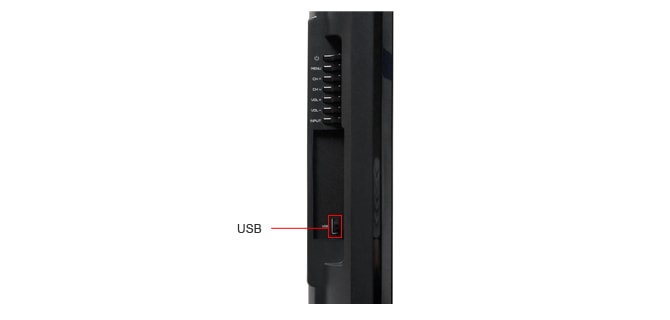
The {{product.name}} has built-in 802.11n WiFi, over which it can sync with other devices via DLNA. It also has the aforementioned Ethernet port for a wired connection.
{{product.manufacturer_specs['Connectivity Tour Image 3']}}
Placement
{{section_header}}{{section.name}}{{/section_header}}
The {{product.name}}'s ports are lined up along a recessed corner in the lower right of the TV's backside. This makes sense for a TV that really wants to be wall-mounted, and it's a little awkward, but we came around to the design. The main problem is that the single A/V and component ports require a big ol' adapter (included) that is supposed to just hang off the bottom of the screen while eight wires protrude from its length.
Audio Quality
{{section_header}}{{section.name}}{{/section_header}}
Audio sounded a bit muffled and distant, coming out of the {{product.name}}'s trio of 10W speakers. The bass was also somewhat weak, but may have sounded better if the display were wall-mounted. The speakers are rear-facing, which means they want to be firing into a wall to imitate the low frequencies of a subwoofer. If the region behind your TV is a mess of wires and devices, as it so frequently is, it's likely that poor audio will result.
There was no dedicated equalizer on this model, which we found strange for such a high-end TV. The Cinema surround mode surprised us further, when it didn't perform as well as the surround emulator on other, much cheaper and smaller, TVs. With a screen size of 55 inches, three speakers have a lot of room in which to throw sound around, so we were surprised by the results. Cinema surround mode felt as though the right and left channels were more strongly weighted, and that was all. There was not really a sense of surround sound beyond this.
We always recommend that external speakers be used, because the ones built-into TVs generally can't compare. This TV, while fancy, is no exception when it comes to audio.
Menu Interface
{{section_header}}{{section.name}}{{/section_header}}
The menu interface is a labyrinth of laggy submenus, which you must navigate using only your remote. There are so many categories within categories, that uncovering options feels more like a choose-your-own-adventure than a selection process. Categories scroll side-to-side at the bottom of the screen, populating upwards into subcategories blocked off in translucent black. Selecting one of these opens a scrolling window of options.

The vast number of categories, subcategories, and options in each section makes finding the exact settings you want at any given moment into an endeavor. Additionally, the menus are a bit slow to navigate in their animation. Pair this with the number of button-presses it takes to get anywhere, and the end result is a system which is certainly pretty, but unappealing to use.

Instruction Manual
{{section_header}}{{section.name}}{{/section_header}}
Like many newer TVs, the {{product.name}} has an on-screen i-Manual instead of a paper version. Unfortunately, it doesn't have a keyword search feature, so it can be difficult to navigate. It does allow for bookmarks, however—if you can manage to find an answer once, you can save it for later reference.
Sometimes the awkward, remote-based navigation of i-Manuals can be gotten around by simply downloading a PDF version. Unfortunately, the PDF adaptation is only for an abridged version that also comes printed in the box, called the Setup Guide. You can download the Setup Guide here.
You may also access a web-based version of the i-Manual here, but it's no more searchable than the TV version.

A manual for so many TV models, they have to be further categorized by type.
Internet Features
{{section_header}}{{section.name}}{{/section_header}}
Netflix and Qriocity, Sony's new movie and music service, have their own buttons on the remote. In addition, Qriocity has its own icon along the bottom of the main menu screen. Every other streaming service you can think of, however, is arranged in a confused cluster under the adjacent category, Internet Content.

Within Internet Content, there is yet another grouping of streaming services nested inside a category called "Bravia Internet Video." This, by the way, is why we called the menu system labyrinthian. Most of these are for niche interests, but others really did not need to be categorized in this hidden trash heap.
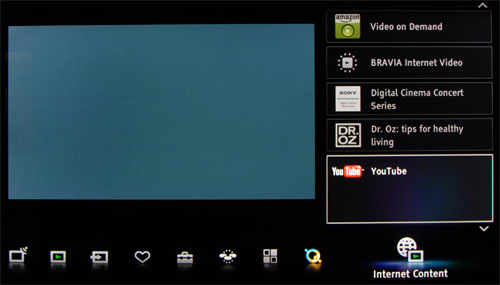
There's another new feature called TrackID, which looks up the information for any song that's currently playing. We've seen features like this on smart phones, but having it built into a TV is a great idea. And for sure, a brief wait is a lot better than vainly attempting to look up a song by its lyrics on Google.
There is also a Skype feature available. This TV does everything it can to prevent you from leaving it for your computer. Of course, things like the implementation of the HTML web browser we don't find very persuasive.
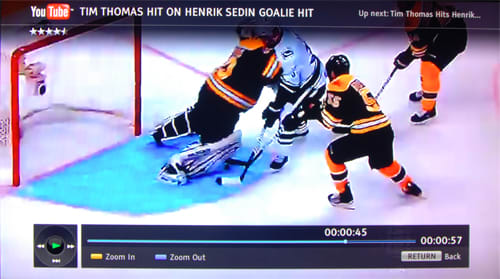
The YouTube playback is a wonderful thing.
"Oh," you might think. "My experiences using the internet have generally been rewarding. Perhaps I will browse the World Wide Web on my new, browser-equipped Sony television." And that's where you would be wrong. Because if you are thinking that thought, you have not yet been embittered to the world by the vain punishment of attempting to browse the internet on a remote control. Hint: it's like trying to use a normal web browser without the mouse. And most of the keys do not work. You just have to press the D-pad fifty or so times, at which point you may press enter. When you need to enter text or a URL, it looks like this:

If you thought navigating through the many paths of streaming content was bad, you are in no way prepared to use this web browser. And honestly, nobody should. If this were intended to function as a browser, instead of another claimed feature on the TV's spec sheet, you would have been able to at least plug in your own keyboard and mouse. The fact that you can't is all the coercion we need to never use the thing again.
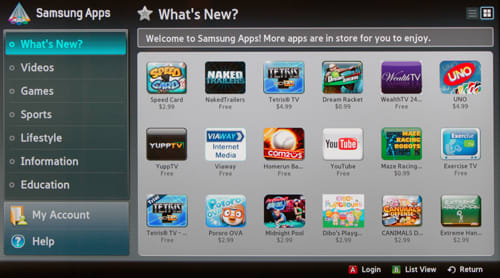
There are also plenty of games to download, free and paid, new and classic
Local Media Playback
{{section_header}}{{section.name}}{{/section_header}}
Usually, when you plug a USB drive into the appropriate port on a modern TV, it asks you if you want to view its contents. Not so for the {{product.name}}, which passive-aggressively goes on with its day without acknowledging that you've done anything. We were forced to navigate to the media playback submenu, at which point we could choose from Photo, Video, or Music. DLNA over the built-in WiFi probably behaves in a similar fashion.
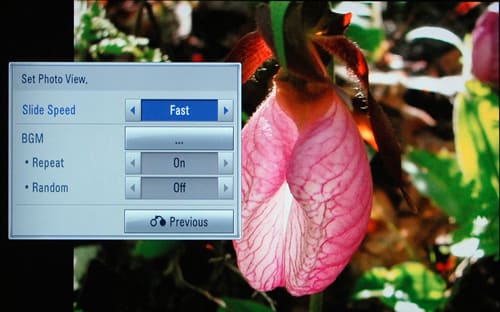
Beyond the simple photo-and-sometimes-your-own-music slideshow of other TVs, the {{product.name}} allows you to create a multimedia playlist including whatever photos, video, and music that you choose. We aren't quite sure when that would be useful, but maybe you want to include photos in your playlist that say "INTERMISSION" in a grainy font.
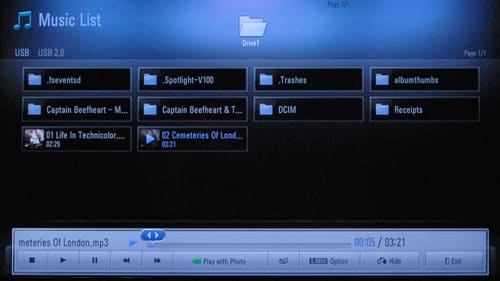
Other Media
{{section_header}}{{section.name}}{{/section_header}}
The {{product.name}} does not support any other media playback.
Power Consumption
{{section_header}}{{section.name}}{{/section_header}}
The {{product.name}} did not do as good of a job as another 55-inch Sony 3D LCD from this year in terms of minimizing energy used. However, it was still quite cheap, averaging $22.59 a year to power, assuming you are watching it five hours a day at a reasonable backlight level. This cost is really quite good for a giant, 55-inch screen, and likely has LED-edgelighting to thank.
Compare this to the plasmas, which have better 3D performance, but cost nearly three times as much to maintain and aren't even as big. Even the word "plasma" sounds like it would use a lot of energy, and it's very true.
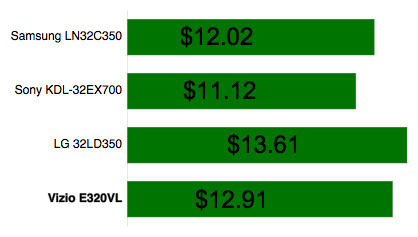
Value Comparison
{{section_header}}{{section.name}}{{/section_header}}
Comparing plasmas to LCDs is a bit like comparing apples and oranges, if apples had a wider viewing angle, while oranges were better at contrast ratio. Regardless, the lower price of the Samsung PN51D550 makes it a very enticing choice for those who require a wide viewing angle or want the TV for its 3D performance. For those who are more concerned with streaming video over WiFi, the Sony offers you choices the Samsung in no way can.
Blacks & Whites
{{section_header}}{{section.name}}{{/section_header}}
The {{product.name}} was much brighter and had a vastly greater contrast ratio. Additionally, it had no problem whatsoever with tunnel contrast and white falloff. Although the Samsung PN51D550 had better greyscale gamma, the Sony was the clear winner in the black and white arena.

Color Accuracy
{{section_header}}{{section.name}}{{/section_header}}
The {{product.name}}'s color temperature was far superior, but the Samsung PN51D550 had a more accurate color gamut. It's relatively even, even with the Sony's slightly-superior color curves.
Motion
{{section_header}}{{section.name}}{{/section_header}}
The Samsung PN51D550 definitely has better superior motion rendering. We weren't sure why, but the motion processor on the {{product.name}} was very jittery. It fell behind in resolution scaling and 24fps rendering, as well, making the Samsung the choice here.
Viewing Effects
{{section_header}}{{section.name}}{{/section_header}}
Plasmas have great viewing angles, and LCDs, in general, don't. This was especially true of the Samsung PN51D550, whose total viewing angle was 154˚, and the {{product.name}}, whose total angle was the pittance of 14˚.
Connectivity
{{section_header}}{{section.name}}{{/section_header}}
The Samsung PN51D550 had an additional component input, but was otherwise the same when it came to connectivity. The {{product.name}} had integrated WiFi, however, while the Samsung required the purchase of a dongle.
Other Comparisons
{{section_header}}{{section.name}}{{/section_header}}
The 3D was superior on the Samsung PN51D550, for sure. It had a very immersive 3D experience, by today's technologically undeveloped standards. If we were to buy a TV for its 3D performance, it would be a plasma.
On the other hand, the Sony is a great smart TV when it comes to multimedia. It has a slew of internet features to go with its integrated WiFi, and a Netflix button right on the remote.
Value Comparison
{{section_header}}{{section.name}}{{/section_header}}
You'd think the Panasonic TC-P50ST30, as a plasma, would have advantages and drawbacks characteristic of its backlight source. However, we were pleasantly surprised by the contrast ratio. With streaming content at least comparable to the {{product.name}} and superior 3D, we would save our thousand dollars and go with the Panasonic.
Blacks & Whites
{{section_header}}{{section.name}}{{/section_header}}
LCDs tend to have the advantage in black and white performance, but the Panasonic TC-P50ST30 is a bit of an exception. Its low brightness was countered by its fantastically-dark black. The contrast ratio of these two screens ended being quite similar, with the Panasonic also having better screen uniformity and greyscale gamma. We must tip our hats to the TC-P50ST30 here.

Color Accuracy
{{section_header}}{{section.name}}{{/section_header}}
The Sony had more consistent color temperature and smoother curves, but the Panasonic TC-P50ST30 had a beautifully accurate color gamut. It's ultimately a personal preference choice here, but overall we prefer the adherence to the Rec. 709 standard.
Motion
{{section_header}}{{section.name}}{{/section_header}}
Unfortunately, neither of these screens are great at motion and resolution scaling. The Panasonic suffers from dreadful artifacts, but the Sony can't seem to deal with 24fps video sources like Blu-ray.
Viewing Effects
{{section_header}}{{section.name}}{{/section_header}}
Plasmas have better viewing angles than LCDs, especially when the LCD in question is the {{product.name}}. The Panasonic TC-P50ST30 is just another plasma whose giant, 154˚ viewing angle towers metaphorically over that of the Sony and its puny 14 degrees. The Panasonic is also much less reflective, to boot.
Connectivity
{{section_header}}{{section.name}}{{/section_header}}
The Panasonic TC-P50ST30 is down an HDMI port from the {{product.name}}, but in exchange, it has... a slot for a memory card. Also, in case the trade could possibly be considered fair, the Sony has integrated WiFi as well.
Other Comparisons
{{section_header}}{{section.name}}{{/section_header}}
Both the Panasonic TC-P50ST30 and the {{product.name}} offer extensive streaming options, so the real difference in the "other" arena centers on 3D performance. As stated earlier, second-generation plasmas like the Panasonic TC-P50ST30 have the only 3D we'd call "watchable" so far.
Value Comparison
{{section_header}}{{section.name}}{{/section_header}}
If you are spending over $2,000 on a TV, you probably aren't overly concerned with a couple hundred dollars difference. That said, it seems to be a fee for the integrated wireless; apart from this feature, the cheaper KDL-33EX720 performs better in every way.
Blacks & Whites
{{section_header}}{{section.name}}{{/section_header}}
With a brighter white and a darker black, the less-expensive KDL-55EX720 had much better contrast as well.

Color Accuracy
{{section_header}}{{section.name}}{{/section_header}}
Both of the Sony models had stellar color accuracy overall: the KDL-55EX720 had slightly better RGB curves, while the {{product.name}} had a slightly more accurate color gamut. It's about even, on the whole.
Motion
{{section_header}}{{section.name}}{{/section_header}}
Motion was one of those areas in which we weren't sure why the more expensive screen performed more poorly. It did, though. Motion was one of the {{product.name}}'s weakest areas.
Viewing Effects
{{section_header}}{{section.name}}{{/section_header}}
Both of these Sony LCDs have the same formats and processing options, but the {{product.name}} falls behind when it comes to viewing angle.
Connectivity
{{section_header}}{{section.name}}{{/section_header}}
These similar models also have identical connectivity, apart from the integrated wireless of the {{product.name}}. The KDL-55EX720 requires the purchase of a dongle for WiFi.
Other Comparisons
{{section_header}}{{section.name}}{{/section_header}}
The 3D was about on par for both Sony TVs in our tests. The {{product.name}} has slightly more immersive crosstalk results, but much weaker color fidelity. This was especially true when it came to blues, which were both undersaturated and erratic.
Both of the displays had the same bevy of streaming content and media features.
Conclusion
The {{product.name}} is a high-end 3D LCD TV with a price tag to boot, but is it worth it? It has all the streaming features you could ever want in the year 2011, but who knows what the future holds; today's Qriocity might be tomorrow's Even-More-Stupidly-Named-Service. Its 3D performance is certainly leaps and bounds ahead of any LCD TV from last year, and it's nice to have that option, even if it isn't very convincing.
This is an internet TV at heart, though, and that's really where its strength lies. Although we were satisfied with the color accuracy and power consumption, the motion rendering and viewing angle left a lot to be desired from such a large investment. If you're dead-set on watching 3D video, a plasma might be the better choice. And if you want the full internet package, another Sony may be a marginally better option at a cheaper price.
Model Series Comparison
{{section_header}}{{section.name}}{{/section_header}}
The KDL-xxHX820 series is a pair of LED-edgelit LCD TVs in the Sony Bravia line. These 1080p-native 3D televisions are new for 2011. They have integrated WiFi and a plethora of video streaming options.
Photo Gallery
{{photo_gallery "Front Tour Image", "Back Tour Image", "Sides Tour Image", "Stand Photo", "Controls Photo", "Remote Control Photo", "Connectivity Tour Image 1", "Connectivity Tour Image 2", "Connectivity Extra Photo", "Menu Main Photo", "Menu 2 Photo", "Internet Features 1 Photo", "Internet Features 2 Photo", "Internet Features 3 Photo", "Local Media Playback 1 Photo", "Local Media Playback 2 Photo"}}
Ratings & Specs
{{manufacturer_specs_table}}
Meet the tester
Jackie Lee is a valued contributor to the Reviewed.com family of sites.
Checking our work.
Our team is here to help you buy the best stuff and love what you own. Our writers, editors, and experts obsess over the products we cover to make sure you're confident and satisfied. Have a different opinion about something we recommend? Email us and we'll compare notes.
Shoot us an email